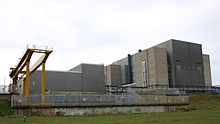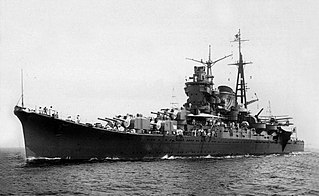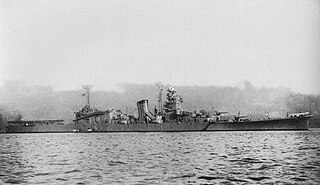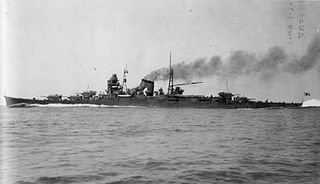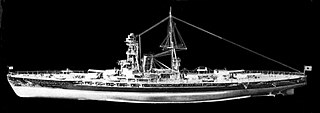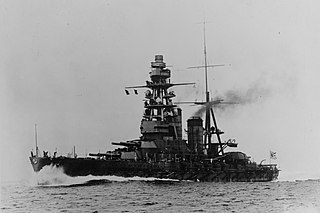Applications
Ships
Ducol has been used for bulkheads in both general construction and against torpedoes, and for light armour in warships of several countries, including the British, Japanese and perhaps Italian navies. [11] After WW2 the highest grades of the commercial shipbuilding steels were based on this type of steel. [12]
Royal Navy

Ducol steel was used in HMS Nelson and HMS Rodney (1927) to save weight. [13]
It was used in British anti-torpedo-system design practice in its last battleships. The internal hull and torpedo bulkheads and internal decks were made of Ducol or "D"-class steel, an extra-strong form of HTS. Much of the load-bearing portions of King George V-class battleships including the weather deck and the bulkheads were made from Ducol [14]
HMS Ark Royal's fully-enclosed armoured hangar and the armoured flight deck which it supported were constructed of Ducol.[ citation needed ]
Other types of armour used on Navy ships:
- HTS = High-tensile steel
- STS = Special treatment steel = homogenous armour
Imperial Japanese Navy


The Imperial Japanese Navy (IJN) made considerable use of Ducol made under licence by Japan Steel Works in Muroran, Hokkaidō, Japan: the company was set up with investment from Vickers, Armstrong Whitworth and Mitsui. [15]
The Mogami-class cruisers were originally designed with all-welded Ducol bulkheads which were then welded to the ship's hull. The resultant faults caused by electric welding used in the structural portions of the hull resulted in deformation, and the main gun turrets were unable to train properly. They were re-built with riveted construction, and the other two were redesigned. [16] [17] [18]
All of the following ships or classes (the list is not complete) used Ducol in structural bulkheads and protective plating:
- Japanese aircraft carrier Kaga (1928)
- Japanese cruiser Takao [b] [20]
- Mogami-class cruisers (x2, 1931), (x2 1933-34)
- Nagato-class battleships x2, (1920, upgraded 1934-36)
- Japanese aircraft carrier Shōkaku (1939) [c]
- Japanese battleship Yamato (1940) [14] [d]
- Japanese battleship Musashi (1940)
- Japanese aircraft carrier Hiyō (1941) [24]
- Japanese cruiser Oyodo (1941) [25]
- Agano-class cruisers x4, (1941–44)
- Japanese aircraft carrier Shinano (1944)
In addition, the IJN's '25-ton' type river motor gun boat had an all-welded hull, protected by 4-5mm Ducol steel.
Italian Navy
The Italian Navy used a similar type of steel to Ducol in its Pugliese torpedo defense system. This underwater "bulge" system was introduced in the Italian Littorio-class battleships, and in the completely rebuilt versions of the Italian battleship Duilio and the Conte di Cavour-class battleships. The inboard-facing side consisted of a layer of silicon-manganese high-tensile steel from 28-40mm thick called "Elevata Resistenza" (ER) steel, which was probably somewhat similar to the British Ducol ("D" or "Dl") Steel used for light armour and torpedo bulkheads in WWII. [26]
- "However, the power of the torpedoes used during WWII rapidly outclassed even the best bulge protection systems and the magnetic pistol, when finally perfected, allowed the torpedo to completely bypass the bulge by detonating under the keel of the ship." [26]
Tanks
During WWII many Soviet tanks used Ducol type steel due to a lack of chromium and nickel. [12]
Bridges
Sumida River

The Eitai-bashi (1926) and Kiyosu-bashi (1928) bridges over the Sumida River in Tokyo seem to have been some of the first bridges to be made with Ducol, at the time a state-of-the-art technology.
The bridges were built by Kawasaki Dockyard Co., to replace earlier crossings which were destroyed in the 1923 Great Kanto earthquake. High-tensile Ducol was used for the lower supports of the Eitai-bashi tied-arch bridge, and for the upper cables of the Kiyosu-bashi self-anchored suspension bridge. The steel was made at Kawasaki's Hyogo Works, Kobe. [27]
- "The Ducol steel was used as the material in cases of the construction of the Eitai bashi and the Kiyosu bashi. The author is not aware if the material has been previously used for a bridge.
- The material investigated by the author has the C content of 0.24-0.30% and Mn of 1.4-1.6% giving a tensile strength 63-71kg/mm2, elongation 20-23% in 200mm gauge and elastic limit 42kg/mm2.
- The Ducol steel seems to be preferable as the bridge building material both in quality and in the cost compared with others such as Ni steel, Si steel and C steel." [5]
Chelsea Bridge

Ducol was also used in the construction of the stiffening girders of Chelsea Bridge (1934-1937) joined by HTS rivets. A small amount of copper was added to the mix to improve corrosion resistance. [7]
Glen Quoich Road Bridge
Used in the construction of the Glen Quoich Road Bridge, Aberdeenshire - built 1955 by Sir William Arrol & Co. crossing the Qoich Water between Mar Lodge and Allanaquoich, not far from where it joins the River Dee. [28] [29] [30]
Pressure vessels

Ducol has been used in pressure vessels including steam boilers and solid wall ammonia converter shells as used in the Haber–Bosch process. Normalised and tempered Ducol W30 has been used in heavy walled nuclear reactors. [31]
In the UK, the British Standard for low alloy steels used for high temperature pressure purposes is BS EN 10028-2:2006. It replaced the old BS1501 Part 2: 1988. [32]
Steam locomotives
The boiler plates for the Southern Railway 4-6-0 Lord Nelson class locomotives, designed by Richard Maunsell in 1926 to work at 250 psi (1,700 kPa), were made of Ducol. [33]
